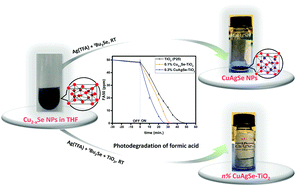Room-temperature conversion of Cu2−xSe to CuAgSe nanoparticles to enhance the photocatalytic performance of their composites with TiO2†
Abstract
Rational design and precise engineering are needed to optimize the structural and chemical parameters of functional materials. In this work, we demonstrate how pre-formed binary metal selenides can be an excellent synthetic choice for the synthesis of ternary coinage metal selenide nanoparticles (NPs) with controlled composition. The mild conditions required to obtain these ternary coinage metal selenide NPs offered an easy synthesis of n% CuAgSe–TiO2 (n = 0.01, 0.1, 0.3 and 1.0 mol%) nanocomposites for photocatalytic applications without compromising the structural and morphological characteristics of TiO2 and without having any organic ligands around the NPs. The use of ternary metal selenide nanocomposites CuAgSe–TiO2 results in a clear improvement in their photocatalytic activity for the photodegradation of formic acid as compared to the well-known benchmark for photocatalysis, TiO2 (P25), and its binary metal selenide nanocomposites Cu2−xSe–TiO2. DFT calculations establish semi-metallic behavior of CuAgSe NPs and show that CuAgSe–TiO2 forms a semimetallic-semiconductor heterojunction allowing a better charge separation to enhance its photocatalytic activity.



 Please wait while we load your content...
Please wait while we load your content...